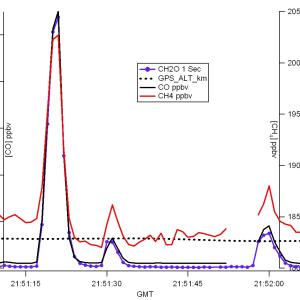The DFGAS instrument utilizes a room temperature infrared (IR) laser source based upon non-linear difference frequency generation (DFG) in the measurement of CH2O.
Mid-IR laser light is generated in the DFG system by mixing the output of two near-IR room temperature laser sources (one at 1562-nm and the other at 1083-nm) in a periodically poled lithium niobate (PPLN) non-linear wavelength conversion crystal. The mid-IR difference frequency at 2831.6 cm-1 (3.53-μm) is generated at the PPLN output and directed through a multipass astigmatic Herriott cell (100-m pathlength using ~ 4-liter sampling volume) and ultimately onto IR detectors employing a number of optical elements. A portion of the IR beam is split off by a special beam splitter (BS) before the multipass cell and focused onto an Amplitude Modulation Detector (AMD) to capture and remove optical noise from various components in the difference frequency generation process. A third detection channel from light emanating out the back of the beam splitter is directed through a low pressure CH2O reference cell and onto a reference detector (RD) for locking the center of the wavelength scan to the absorption line center. The mid-IR DFG output is simultaneously scanned and modulated over the CH2O absorption feature, and the second harmonic signals at twice the modulation frequency from the 3 detectors are processed using a computer lock-in amplifier [Weibring et al. [2006].
Ambient air is continuously drawn through a heated rear-facing inlet at flow rates around 9 standard liters per minute (slm), through a pressure controller, and through the multipass Herriott cell maintained at a constant pressure around 50-Torr. Ambient measurements are acquired in 1-second increments for time periods as long as 60 to 120-seconds (to be determined during the campaign), and this will be followed by 15-seconds of background zero air acquisition, using an onboard CH2O scrubbing unit. The zero air is added back to the inlet a few centimeters from the tip at flow rates ~ 2 to 3 slm higher than the cell flow. This frequent zeroing procedure very effectively captures and removes optical noise as well as residual outgassing from inlet line and cell contaminants. Retrieved CH2O mixing ratios are determined for each 1-second ambient spectrum by fitting to a reference spectrum, obtained by introducing high concentration calibration standards (~ 3 to 7-ppbv) from an onboard permeation calibration system into the inlet approximately every hour. The calibration outputs for the two permeation tubes employed are determined before and after the field campaign using multiple means, including direct absorption employing the Beer-Lambert Law relationship. The 1-second ambient CH2O results can be further averaged into longer time intervals for improved precision. However, in all cases the 1-second results are retained. This flexibility allows one to further study pollution plumes with high temporal resolution, and at the same time study more temporally constant background CH2O levels in the upper troposphere using longer integration times.



